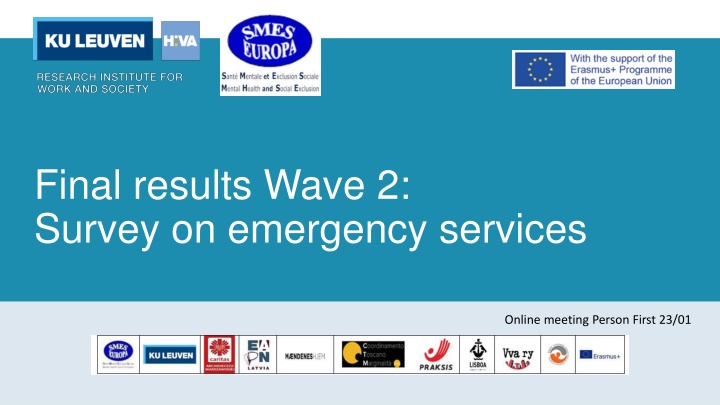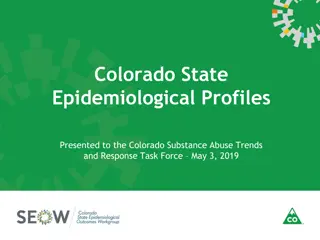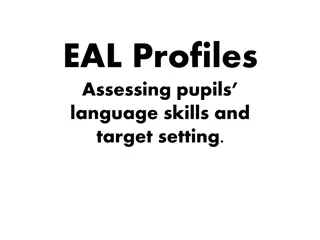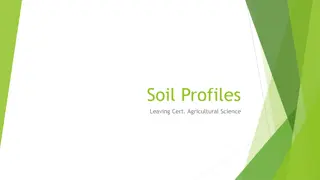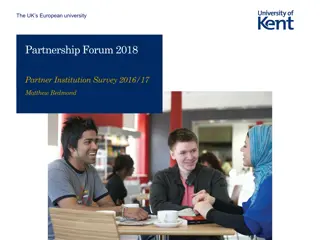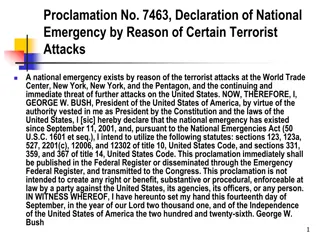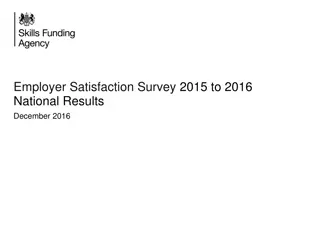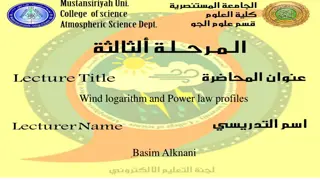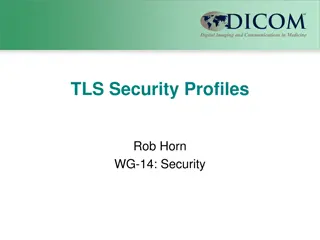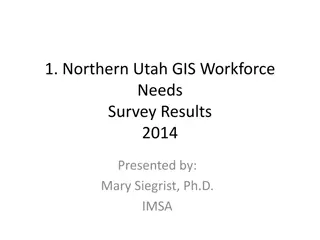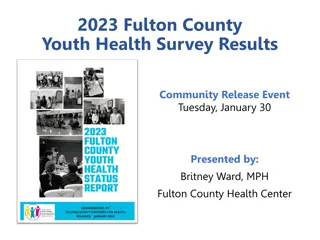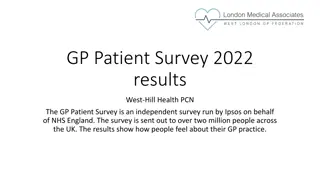Analysis of Emergency Services Survey Results and Organizational Profiles
This report presents the findings of a survey on emergency services, detailing the profiles of organizations, services offered, user needs, and collaboration efforts. The data reveals insights into the distribution of services, user requests, and ensuring access to essential pillars of support.
Download Presentation

Please find below an Image/Link to download the presentation.
The content on the website is provided AS IS for your information and personal use only. It may not be sold, licensed, or shared on other websites without obtaining consent from the author.If you encounter any issues during the download, it is possible that the publisher has removed the file from their server.
You are allowed to download the files provided on this website for personal or commercial use, subject to the condition that they are used lawfully. All files are the property of their respective owners.
The content on the website is provided AS IS for your information and personal use only. It may not be sold, licensed, or shared on other websites without obtaining consent from the author.
E N D
Presentation Transcript
Final results Wave 2: Survey on emergency services Online meeting Person First 23/01
Table of contents I. II. III. IV. Profile of organisations Services and needs Collaboration Giving a voice to users/guests 2
Category Frequency Percentage Country Portugal Greece Latvia Italy Poland Denmark Slovenia Belgium Finland Grand Total Frequency Percentage 12 10 9 9 7 6 5 4 3 65 19 15 14 14 11 9 8 6 5 100 41 11 5 5 3 63 17 8 8 5 Private, subsidised Public Mixed Private, non subsidised Other (religious organisation, association, non-profit community-based) Grand Total 65 100 Level Local Regional National National and regional National and local Grand Total Frequency Percentage 34 17 12 1 1 65 52 26 19 2 2 100 4
Services of the organisations (65 responses) 60% 57% 51% 50% 42% 40% 40% 31% 29% 28% 30% 22% 19% 17% 20% 11% 10% 0% Frequency Percentage The four pillars 1. Social assistance 53 85 2. Home & housing services 33 51 3. (Mental & medical) health services 36 55 4. Empowerment & rehabilitation services 29 45 6
Most frequent requests from users/guests (59 responses) 60% 50% 44% 41% 37% 36% 40% 31% 25% 30% 20% 20% 10% 8% 5% 10% 3% 0% Frequency Percentage The four pillars 1. Social assistance 41 69 2. Home & housing services 26 44 3. (Mental & medical) health services 23 39 4. Empowerment & rehabilitation services 30 51 7
Q&A four pillars How can we ensure that users have recourse to the four pillars? 8
Needs of users/guests versus services of the organisations Needs (59 responses) Services (65 responses) 57% 60% 51% 50% 44% 42% 41% 40% 37% 40% 36% 31% 31% 29% 28% 30% 25% 22% 20% 19% 17% 20% 11% 10% 8% 10% 5% 3% 0% 9
Difficulties in responding to needs (53 responses) Qualification of paid staff Social qualifications Median % Average % 35% 32% 30 40 30% 30% Mental health specialists 0 8 23% 25% 20% General medical workers 3 12 15% 15% 9% 10% 6% 6% 5% 0% Insufficient financial resources Inefficient services Legal barriers Un(der)qualified staff Low motivation users/guests Understaffing Fearful/being reserved Insufficient financing of projects and lack of funds to employ qualified staff, increasing costs of building maintenance, lack of long-term financial support Legal and administrative barriers, the complexity of the regularisation process of undocumented migrants No intrinsic motivation, difficulties in retaining and maintaining users in the intervention plan Accessibility problems/high barriers, lack of progressive responses, waiting lists and procedures Understaffing (sick leave, holidays), lack of conomical resources for additional/trained staff No adequate staff training opportunities, lack of funding to attract specialists Feeling ashamed of their difficulties, fearful of society's stigmatising perception 10
Q&A Difficulties in responding to needs How to deal with legal thresholds (e.g., the complexity of the regularisation process of undocumented migrants, ) How to ensure a more qualified workforce? 11
Latent needs (48 responses) & mismatch (33 responses) 60% 74% (N= 48) see latent needs that users/guests do not express 60% (N= 34) experience a mismatch between needs and services 60% 55% 50% 46% 50% 40% 40% 30% 27% 30% 24% 19% 20% 20% 15% 10% 10% 10% 9% 8% 8% 10% 10% 0% 0% 12
Q&A Latent needs and mismatch How to meet the (latent) need for mental health support more efficiently? How can we better tailor services to the real need of homeless people? What is needed to make services sufficient/efficient (more accessible, shorter waiting times, adapted to users' needs/characteristics, ...)? 13
Implications for staff (41 responses) 70% 59% Workers need knowledge and skills that are wide-ranging yet flexible and effective in specific circumstances (Maguire, 2012) 60% 50% 40% 30% 24% 20% 10% 5% 10% 0% Supervision/training needed Need for qualified staff More staff needed More regular staff needed Relational skills, flexibility and creativity in intervention, skills in evaluation and observation, knowlegde of different services and procedures Psychiatrist, health professionals, physiotherapist, ergotherapist, psychiatric nurse Need more staff to work even more individually with users ... Frustration with rotatory door for staff but especially for users ... 14
Q&A - Implications for staff How to prevent staff drop-outs and burnouts? How to train or educate staff? How to achieve a good working atmosphere and organisation of work? 15
The type of organisations/services they collaborate with (64 responses) 100% 89% 88% 90% 74% 74% 74% 80% 63% 70% 60% 50% 40% 29% 30% 20% 10% 0% Social (Medical) Health Outreach services/street work Mental health Housing Job Other Private home search agencies, public shelters and housing first, housing departments of the city authority, outreach housing services, Labour offices, municipal job centres, public employment office, local entrepreneurs , state employment agency, Municipality streetwork, medical street working, mobile units of risk reduction and harm minimization programs Psychiatric hospital,public mental health facilities, psychiatrists, substance abuse services, Services for immigrants, lawyers, cultural services, volunteer associations, civil society (police, ), Public welfare, center for social services, social security services, Hospitals, GPs, health centers, outpatient clinics, emergency services, 17
Collaboration: Q&A - Discussion How can we strengthen networks or collaborations? Which networks and collaborations are crucial? 18
The way organisations give a voice to users/guests (57 responses) 90% 81% 91% (N= 59) give a voice to users/guests 80% 70% 60% 50% 40% 30% 14% 20% 12% 7% 5% 4% 10% 0% Surveys, evaluation forms, interviews, meetings, complains procedures, etc. Daily/informal conversations Active involvement Reports/magazines Peer workers Advocacy The active participation of residents, by holding regular user meetings, and their involvement in the daily dynamics, we take their opinion seriously in our requests and of course we do not make decisions for them without them A magazine where users can write articles about whatever they like, a book of praise and complaints We talk with our street patients, listening to them, the constant and direct conversation between our association and the user Engagement of a peer helper, all services include in their teams peer workers from the target communities Often invited to participate as speakers in meetings with political representatives and in conferences Interviews from social services in the presence of interpreters, box of complaints, evaluation forms 20
Q&A Giving a voice How to improve user involvement/active participation and the relationships with users? 21
THANK YOU 22
